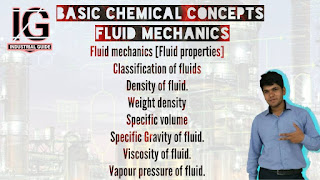Fluid mechanics - Density, Specific Gravity, Viscosity, Vapour pressure etc
Blog Contents -
- Fluid mechanics [Fluid properties]
- Classification of fluids
- Density of fluid.
- Weight density
- Specific volume
- Specific Gravity of fluid.
- Viscosity of fluid.
- Vapour pressure of fluid.
Interview Questions from this blog
- What is definition of fluid?
- Classifications of fluid
- What are Newtonian fluids and Non Newtonian fluids?
- Why density is depend on Temperature & Pressure?
- What is classification of Non Newtonian fluid?
- What is relation between mass density & mass density?
- What is relation between Vapour Pressure & Temperature?
- How vapour change with molecular forces?
[ads id="ads1"]
Fluid definitions
Fluid is a substance which under goes continuous deformation (flows) when subjected to external force or gravity.
Other definitions
- Fluid is a substance which one’s particles easily move and change their respective position with other particles when substance is free or under pressure or under gravity
- Fluid is capable to flow when allowed to flow freely. or Fluid is a substance tends to conform to the containers outline or free to flow
- Fluid has no definite shape but when it fill in any Container it follow container's shape called Fluid
[ads id="ads1"]
Classification of fluid
Fluid classification is as per below
 |
| Classification of fluid |
[ads id="ads1"]
Definitions of Fluids of each type:
Ideal Fluid -- Ideal fluid is a fluid which does not offer any resistance in flow / deformation / shape change.
- Fluid doesn't has viscosity
- It is friction-less & In compressible.
- Ideal fluid is not exists It is imaginary fluid.
Real Fluid
- Fluid found in nature and reality called real fluid.
- Real fluid offers resistance when it is in motion.
- Fluids which's density depends on Temperature & Pressure called Compressible fluid.
- Fluid of which the density is sensible to change in temperature or pressure called Compressible fluid
- Generally gases are compressible fluids.
- If density of fluid is not affected by change in temperature or pressure applied in temperature that fluid is called Incompressible fluid.
- Generally liquids are incompressible
- Fluids which follows Newton's law of viscosity are called Newtonian fluids.
- Newton's law of viscosity : The fluids for which the ratio of the shear stress to the rate of shear is constant
- Fluids which are not following newton's law of viscosity calling Non Newtonian fluid
Density of fluid [Mass density]
- Density ⍴ or mass density of fluid is ratio of Mass of fluid m per unit Volume V
- SI unit of Density is Kg/m3
- Density of water at 4℃ [277K] is 1000 kg/m3
Density ⍴ = Mass (m) / Unit Volume (V)
- Density is dependent on Temperature and Pressure.
- As per Ideal Gas Law
PV = nRT
- When Temperature is increases Volume of fluids increases.
- When Pressure is Increases Volume of fluid decreases.
- Generally Density of fluid is not much change in slight change in Temperature.
- Gas density is change higher than liquid in raise temperature.
[ads id="ads1"]
Example of Density -
Copper cube sink in water, but in mercury it float.
Case 1 : Copper Cube in Mercury
Why? -
Density of Mercury : 13600 kg/m3
Density of Copper : 9000 kg/m3
Copper is light in comparison.
This is the reason Copper cube if floating
Case 1 : Copper Cube in Water
Why? -
Density of Water : 999 kg/m3
Density of Copper : 9000 kg/m3
Water is light in comparison.
This is the reason Copper cube if floating
Density Chart - Download now
Weight density
- Weight of fluid per unit volume.
- Weight density of Water at 4°C : 9810 N/m3
- Relation between Mass density & Weight density
w = ⍴ g
- g = gravitational force 9.81 m/s2
[ads id="ads1"]
Specific Volume
- It is volume in unit mass
- unit : m3/kg
Specific Gravity [ Sp.Gr., Relative Density]
Its ratio of Density of fluid to Density of standard fluid.Standard fluids
Liquid - Water at 4℃, 1 Atmospheric pressure.
Air - Air at 20℃, 1 Atmospheric
Unit : Unit less [You can consider kg/m3]
Unit Calculation -
[ads id="ads1"]
Viscosity
Fluid is a substance able to flow but there is resistance in flow is called Viscosity- Honey has more viscosity so it is not flow freely.
- Water has less viscosity so it flows more freely.
- It is not depend on Pressure.
- Viscosity decrease when temperature increase. [ When temperature rises molecular vibration also increases which makes fluid free and reduce it's viscosity].
- Viscosity governed by Cohesive forces[Attractive forces].
Viscosity calculation
Force is proportional to velocity and area and inversely proportional to DistanceF ∝ u A / YF = Force required to move fluid from two parallel layers 1 & 2.
F = μ u A / Y
μ = Viscosity of fluid
Coefficient of Viscosity, Dynamic Viscosity
F / A = μ u / Y
𝛕 = F / A𝛕 = μ * u / Y
We need velocity gradient to measure viscosity.μ = 𝛕 / (du/dY)
Velocity gradient is velocity of fluid with respect to distance traveled.
This is Newton's law of viscosity
- Viscosity μ is Shear stress required to produce unit flow [Shear deformation].
- Unit : N.s/m^2 [SI Unit]
- Kinetic Viscosity of fluid is ration of viscosity of fluid to density. 𝝂 = μ/⍴
[ads id="ads1"]
Newtonian & Non Newtonian fluid
Newtonian fluid definitions
- Shear stress to Rate of shear Ratio of is constant
- Fluids which has velocity gradient equal to Shear stress applied.
- Fluid which has 45° angle graph in Shear stress vs Velocity gradient du/dy
- Examples - All gases, Air; Liquids - Kerosene, alcoho





![Specific Gravity [ Sp.Gr., Relative Density] formula Specific Gravity [ Sp.Gr., Relative Density] formula](https://blogger.googleusercontent.com/img/b/R29vZ2xl/AVvXsEgA12lImGA4e813sjsZK8-KsJ_yxqLg5BeqmjR1Tr5OId1NV6uryy5bSAMN_FUT-9nYNARpwBM7ix_Mib_hMrtjBCkN43TkwsaplWush1j2NQ4HxeFlZ8MkACvHG4NHAhwLiVWMM37of4w/s1600/specific%252Bgravity.JPG)


